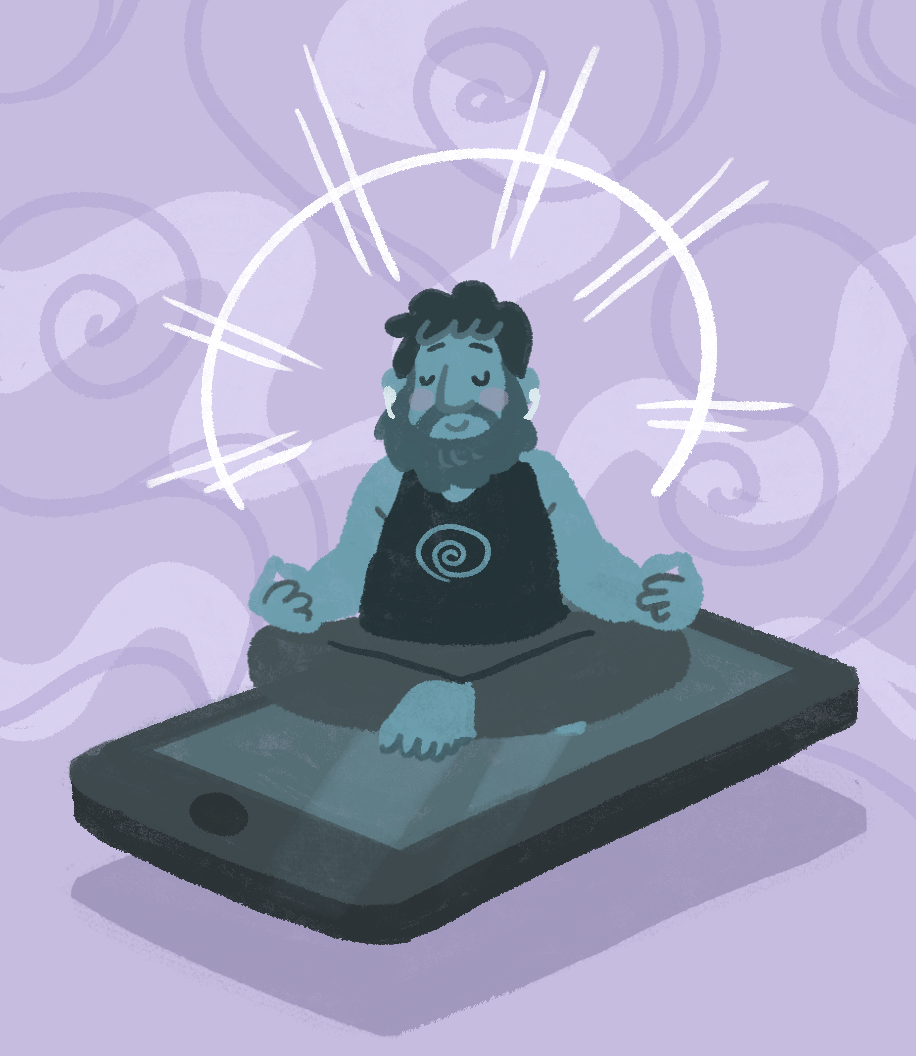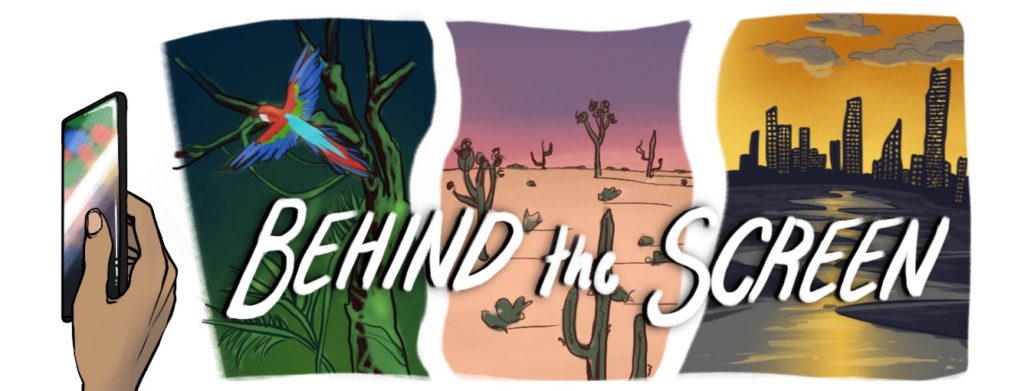Behind the Screen: Meditation apps combine technology, aspects of Buddhist practice

(Katelyn Dang/Illustrations director)
By Yana Edelen
April 28, 2022 7:27 p.m.
With a growing digital world, social media can be used to highlight self-improvement practices, but the popular notion of sharing one’s best life does not always equate to living it. In “Behind the Screen,” columnist Yana Edelen will explore the intersection between social media and wellness trends and consider how the psychology behind the former can impact the journey of self-development.
On devices that facilitate connection, meditation apps provide a space to turn inwards.
Through teaching the applications of mindful living, these platforms combine Buddhist wisdom with new technological knowledge, said mindfulness educator Mitra Manesh. Meditation apps can be a useful introductory tool to engage with the practice, but Manesh said their efficacy can be improved by aiming to create a sense of community.
“People see a lot of benefit (from apps) – people who would never start on their own are meditating,” Manesh said. “I want to celebrate that and acknowledge that, but I also want to say we need something beyond that.”
Sharing collective and personal wisdom connects individuals, Manesh said. By recording anecdotes from her own life and intergenerational stories on her app, Innermap, Manesh said she can illustrate life lessons rooted in Eastern-based principles. She also plans to expand her platform to allow users to share their own impactful moments, as she said mindfulness apps that exclusively feature narratives told by influencers can isolate listeners.
“I want to celebrate a person that I saw … (helping) somebody to buy their groceries,” Manesh said. “I want somebody who stopped and helped someone on the street. I want to celebrate that that’s how you make that a norm – by acknowledging it and saying, ‘Oh, that was wonderful. I saw that and it inspired me to go and help somebody else.'”
Mindfulness apps are centered around the cultivation of certain qualities such as compassion, but distinguished professor of Buddhist studies Robert E. Buswell said meditation encompasses many techniques aimed at focusing on the present moment and controlling states of mind. The goal of the practice is to see reality as it is, and Buswell said this leads to an awareness of the impermanence of all facets of life. Through understanding the shifting nature of reality, Buswell said one comes to accept the pervasive unsatisfactoriness of life and limited control one has over their own path.
[Related: Behind the Screen: Creative outlets enable greater self-reflection on travel experiences]
While mindfulness practitioners in Buddhist contexts emphasize solitude, Manesh said the absence of a community element can lead to disengagement with apps over time. Users can grow disinterested in meditation or may alternatively become reliant on the services provided by apps, as Manesh said guided practices are meant to be a point of reference, rather than a crutch. Guided meditations through an app may not provide the same introspective value as simply observing the mind, but Manesh said any practice is more helpful than none, as awareness of unpleasant states of consciousness is key in the journey of learning about oneself.
In therapeutic and self-development based contexts, such as apps, Buswell said the Buddhist concept of mindfulness has been adapted to fulfill fundamentally different objectives. For instance, the notion of impermanence is portrayed positively, as he said it implies that all human suffering is temporary. In contrast, he said Buddhist tradition emphasizes the tie between impermanence and unsatisfactoriness with the aim to completely detach oneself from the physical world.
“In many cases, this Buddhist dimension has been turned exactly on its head to make people think they’re going to have a better quality of life by doing this (engaging in mindfulness),” Buswell said. “Whether it’s really about a better quality of life, although that certainly can be a byproduct of access, they’re (Buddhists are) trying to find a way out of life (and) out of births and deaths. That’s the ultimate goal.”
Teachers who approach mindfulness as a life enhancing practice have their roots in the tradition, as Buswell said app developers are typically trained in Buddhist countries. While maintaining transparency about the origins of the practice, Buswell also said mindfulness apps tend to isolate the concept from its religious contexts. In Western cultures, meditation is valued as a therapeutic technique, and Buswell said the psychological benefits gained from mindfulness apps can move some users to apply the broader wisdom surrounding the practice.
“(The therapeutic element of mindfulness) may be the mainstream Buddhist practice from this point on – Buddhism without any Buddhist dimension,” Buswell said.
For Music Meditation Club chair and alumnus Christian Diaz, meditation is a peaceful space that he can retreat to when dealing with stress and overwhelming situations, he said. He was initially drawn to mindfulness amid a mental health crisis, and Diaz said the practice has taught him to prioritize his spiritual well being and approach stressors with a sense of compassion.
[Related: Student organization seeks to alleviate ailments through artistic expression]
Mindfulness apps can be a part of a holistic personal practice, but Diaz said one drawback of the useful tool is their often costly price. While meditation does not require any money or additional resources, he said apps typically commercialize and profit from the practice. The popularity of mindfulness has led to variety of available resources, including apps that originated as business venture, Manesh said. For her, independently funding the development of Innermap means that the app aligns with her focus of teaching mindful living.
“I always believed in the marriage of technology and any mindfulness practice, but the question is, ‘What is the purpose of that usage?,'” Manesh said. “If you’re only speaking about making more money, it may not carry that and fulfill that purpose.”
Resources and extensive time are not required to approach life more mindfully, Manesh said, as anyone can start by pausing to explore the sensations of the body and mind. Viewing mindfulness apps as an entry tool and understanding their limitations is the first step in experiencing their associated benefits, Manesh said.
“Technology on its own doesn’t have consciousness,” Manesh said. “Our consciousness determines how the consciousness of technology is going to serve us or hurt us.”



